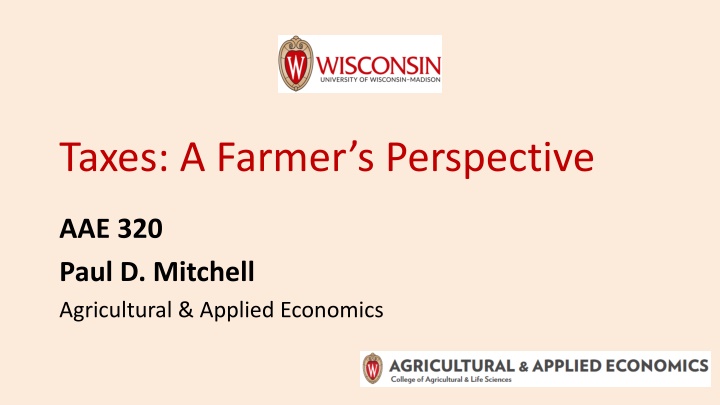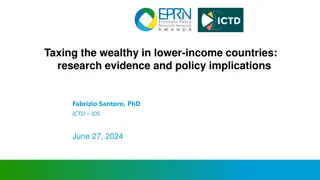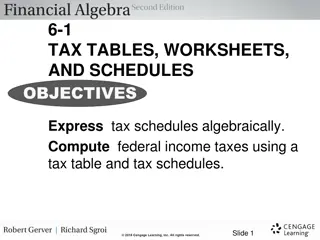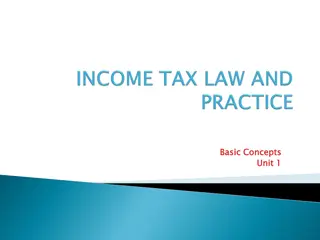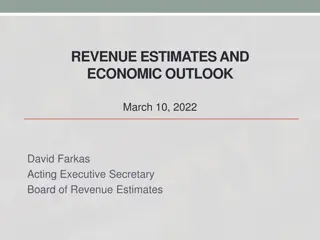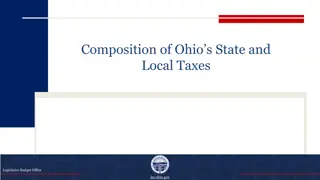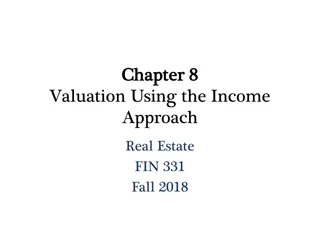A Farmer's Perspective on Taxes and Income Reporting
Explore the practical workings of major types of taxes for farmers, including property, sales, employment, income, self-employment, gift, and estate taxes. Delve into income tax reporting with IRS Form 1040, itemized deductions, taxable income calculation, and understanding US progressive income tax brackets for 2020. Gain insights into how farmers navigate tax obligations and optimize their financial planning.
Download Presentation

Please find below an Image/Link to download the presentation.
The content on the website is provided AS IS for your information and personal use only. It may not be sold, licensed, or shared on other websites without obtaining consent from the author.If you encounter any issues during the download, it is possible that the publisher has removed the file from their server.
You are allowed to download the files provided on this website for personal or commercial use, subject to the condition that they are used lawfully. All files are the property of their respective owners.
The content on the website is provided AS IS for your information and personal use only. It may not be sold, licensed, or shared on other websites without obtaining consent from the author.
E N D
Presentation Transcript
Taxes: A Farmers Perspective AAE 320 Paul D. Mitchell Agricultural & Applied Economics
Learning Goal Understand from a practical perspective how major types of taxes work for farmers
Taxes Commonly Paid by Farmers Property (real estate) taxes Sales taxes Employment taxes Income taxes Self-employment taxes Gift taxes Estate (death) taxes Our focus in AAE 320
Income Taxes IRS Form 1040: Income taxes List income sources Wages/salaries Dividends, pensions, social security, Bring in Schedule 1: Line 6 Calculate Adjusted Gross Income (AGI): Line 7 20% business income deduction Line 9 Schedule 1 Business income: Schedule C or C-EZ (line 12) Capital Gain/Loss: Schedule D (line 13) Depreciation Recapture: Form 4797 (line 14) Farm Income/Loss: Schedule F (line 18) Adjustments on Schedule 1 Deductible part of SE Tax: Schedule SE (line 27)
Income Taxes Itemized Deductions (Schedule A) If choose to itemize, deduct property taxes paid, state taxes and mortgage interest on home here Calculate Taxable Income Big change in 2018: Standard Deduction Increased Before 2018: $5,800 single, $11,600 married filing joint 2018 & After: now $12,000 single and $24,000 married filing joint Calculate taxable income as AGI minus deductions, then calculate Income Tax (line 44) from tax tables by bracket Adjustments for various credits and other taxes
US has a Progressive Income Tax Tax Brackets for 2020 Rate 10% 12% 22% 24% 32% $163,301-$207,350 $326,601-$414,700 35% $207,351-$518,400 $414,701-$622,050 37% >$518,400 Single < $9,875 $9,876-$40,125 $40,126-$85,525 $85,526-$163,300 Married Filing Joint < $19,750 $19,751-$80,250 $80,251-$171,050 $171,051-$326,600 Brackets indexed for inflation, so cut offs adjusted annually >$622,050
US has a Progressive Income Tax
$250,000 $200,000 Tax Owed $150,000 $100,000 $50,000 $0 $0 $100,000 $200,000 $300,000 Taxable Income $400,000 $500,000 $600,000 $700,000 35% 30% Average Tax Rate 25% 20% 15% 10% 5% 0% $0 $100,000 $200,000 $300,000 Table Income $400,000 $500,000 $600,000 $700,000
$50,000 $40,000 Tax Owed $30,000 $20,000 $10,000 $0 $0 $20,000 $40,000 $60,000 $80,000 $100,000$120,000$140,000$160,000$180,000$200,000 Taxable Income 25% Average Tax Rate 20% 15% 10% 5% 0% $0 $20,000 $40,000 $60,000 $80,000 $100,000$120,000$140,000$160,000$180,000$200,000 Table Income
Self-Employment Tax: (Schedule SE) If you have self-employment income (Schedule F, CRP Payments, Schedule K-1, Schedule C), file Schedule SE Employment taxes are 15.3% on first $132,900 earned and 2.9% on anything above $132,900 (indexed for inflation) Normally your employer pays of your employment taxes, but if you are self-employed, so you are your employer Schedule SE line 5: calculate self-employment taxes owed Schedule SE line 6: deduce 50% of SE taxes from your income, as though your employer paid them
Other Taxes Property taxes, Sales taxes, Employment taxes Gift Taxes: If you give something to someone, you may owe gift tax (Gift tax return Form 709) Estate tax: when you die, your estate may owe taxes (Estate tax return Form 706)
